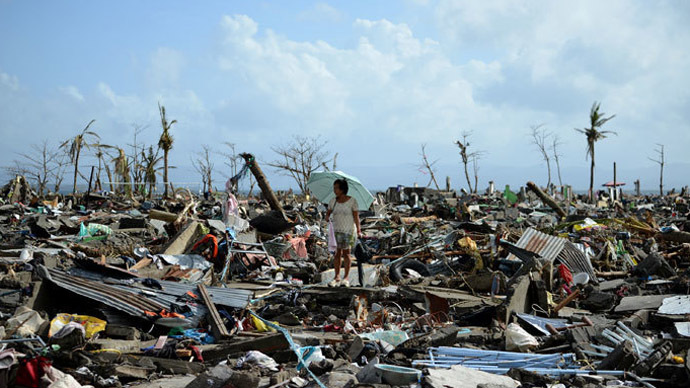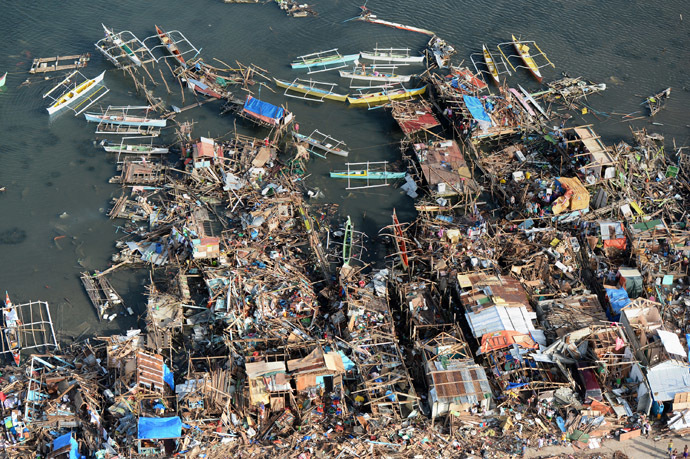http://rt.com/news/philippines-state-national-calamity-544/
Three days after the typhoon made landfall, authorities are struggling to come to grips with the aftermath of one of the strongest typhoons ever recorded.
Forty-one of the country’s 80 provinces were affected, with Secretary to the Cabinet Rene Almendras saying that in the worst affected areas, the destruction had been “total.”
An estimated 10,000 people are believed to have been killed in Tacloban – a city of over 200,000 southeast of the capital, Manila – which bore the brunt of the storm. Flattened by massive waves and battered by winds reaching speeds up to 235 miles an hour, Tacloban remains littered by the dead, some covered with tarps, others left lying out in the open with looks of horror reportedly etched on their faces. The United Nations said officials in Tacloban had seen one mass grave of 300 to 500 bodies, Reuters reported. Relief workers fear that ground water may be contaminated by decaying bodies, and fears are growing of a massive public health crisis.
The city has also been gripped by looting, with authorities dispatching police and military reinforcements to restore order. A Philippine Red Cross truck carrying medical supplies was reportedly attacked while heading to the city. Manila has said it will not hesitate in deploying more police officers if necessary. Locals have already reportedly formed local militias and have promised to shoot looters to protect their property.
Death, hunger and looting: Typhoon-ravaged Philippines declares state of national calamity
In the wake of Typhoon Haiyan, which left thousands dead and many more displaced and survivors battling for survival amid devastation and chaos, the Philippines has declared a state of national calamity to help restore order to the reeling nation.
In a primetime television speech delivered Monday, President Benigno Aquino said: "We declare a state of national calamity to hasten the action of the government to rescue, provide help and rehabilitate the provinces affected by [Haiyan]."
The declaration will also help the government control the prices of staple goods, with many in the country reduced to begging for food and water. Aquino called for patience as the scope of the damage frustrated efforts to coordinate relief operations.
“The extent of the devastation brought us back to a situation where information was passed on from one person to another. There was no television, radio and internet,” he said.
Noting how the devastation reduced people to word-of-mouth communication, Aquino vowed help would arrive in the coming days.
"My message: Staying calm, prayer, and helping each other are what will lift us from this challenge," he said.
The declaration will also help the government control the prices of staple goods, with many in the country reduced to begging for food and water. Aquino called for patience as the scope of the damage frustrated efforts to coordinate relief operations.
“The extent of the devastation brought us back to a situation where information was passed on from one person to another. There was no television, radio and internet,” he said.
Noting how the devastation reduced people to word-of-mouth communication, Aquino vowed help would arrive in the coming days.
"My message: Staying calm, prayer, and helping each other are what will lift us from this challenge," he said.
Counting the dead, accounting for the missing
Three days after the typhoon made landfall, authorities are struggling to come to grips with the aftermath of one of the strongest typhoons ever recorded.
Forty-one of the country’s 80 provinces were affected, with Secretary to the Cabinet Rene Almendras saying that in the worst affected areas, the destruction had been “total.”
An estimated 10,000 people are believed to have been killed in Tacloban – a city of over 200,000 southeast of the capital, Manila – which bore the brunt of the storm. Flattened by massive waves and battered by winds reaching speeds up to 235 miles an hour, Tacloban remains littered by the dead, some covered with tarps, others left lying out in the open with looks of horror reportedly etched on their faces. The United Nations said officials in Tacloban had seen one mass grave of 300 to 500 bodies, Reuters reported. Relief workers fear that ground water may be contaminated by decaying bodies, and fears are growing of a massive public health crisis.
The city has also been gripped by looting, with authorities dispatching police and military reinforcements to restore order. A Philippine Red Cross truck carrying medical supplies was reportedly attacked while heading to the city. Manila has said it will not hesitate in deploying more police officers if necessary. Locals have already reportedly formed local militias and have promised to shoot looters to protect their property.
So far, Tacloban is relying almost entirely for supplies and evacuation on just three military transport planes flying from nearby Cebu. Aquino said 24,000 family food packs had been distributed in Tacloban on Sunday, while 18.7 billion pesos ($430 million) had been set aside from calamity funds, contingency funds, and savings for places hit by Haiyan. He said 22 foreign countries had provided aid.
Around 2,000 people, meanwhile, remain missing in the seaside town of Basely alone, which is located about 10 kilometers across a bay from Tacloban. Other coastal areas caught on Haiyan's path are likely to have suffered similar levels of destruction, though efforts to survey the damage or make a full account of the dead have been severely dampened.
The country’s government has so far confirmed 1,744 deaths.
Both the official and unofficial death tolls are likely climb once officials reach more remote areas. Guiuan, a town of 40,000 in eastern Samar province, was largely decimated, although it does not figure into the casualty tabulations.
Around 2,000 people, meanwhile, remain missing in the seaside town of Basely alone, which is located about 10 kilometers across a bay from Tacloban. Other coastal areas caught on Haiyan's path are likely to have suffered similar levels of destruction, though efforts to survey the damage or make a full account of the dead have been severely dampened.
The country’s government has so far confirmed 1,744 deaths.
Both the official and unofficial death tolls are likely climb once officials reach more remote areas. Guiuan, a town of 40,000 in eastern Samar province, was largely decimated, although it does not figure into the casualty tabulations.
"The only reason why we have no reports of casualties up to now is that communications systems ... are down," Colonel John Sanchez posted on the Philippines Armed Forces’ Facebook page, Reuters reported.
Farther west on the on the islands of Cebu and Panay, which also suffered direct hits from the typhoon, authorities have been hampered in their ability to assess the devastation.
Overall, more than 600,000 people were displaced by the storm across the country, with some lacking access to basic amenities such as food, water or medicine, the UN says.
Massively disrupted transportation and communications links have equally affected the ability for authorities to recover the dead and deliver relief to affected areas. Thirty provinces remain without electricity, and around half that number are having problems with phone and Internet connections. Although telecommunication firms believe service should be restored within days, restoring the national power grid in its entirety could take up to two months.
American military search-and-rescue helicopters, surveillance planes and Marines headed towards the central Philippines on Sunday to survey the devastation and assist survivors whose neighborhoods were completely inundated.
President Aquino said 21 other countries had provided aid, including Indonesia, the UK, Japan, Singapore, New Zealand and Hungary.
http://www.zerohedge.com/news/2013-11-11/meanwhile-philippines-there-nothing-left-loot
Meanwhile In The Philippines, There Is "Nothing Left To Loot"
Submitted by Tyler Durden on 11/11/2013 20:02 -0500


"We need help!" is the sad handwritten sign hanging outside a shuttered church in the Philippine town of Tacloban surrounded, asReuters reports, by uncollected corpses and canyons of debris. Demand for relief is huge and despite 66 tons of supplies having landed since Saturday, they are not reaching those who need them the most as "people are roaming around the city, looking for food and water," because aid trucks from the airport struggle to enter the city because of the stream of people and vehicles leaving it. "People are angry. They are going out of their minds," warned one aid-worker as relief was delayed due to security concerns "there might be a stampede," after dark. The terrible state of affairs is summed up by on aid worker, "there is nothing left to loot... even if you have money there is no food to buy. There is nothing here." Police are trying to enforce a curfew...
Some context... (via @colinjones)

The Human Side...

Tacloban city administrator Tecson Juan Lim says the death toll in this city alone "could go up to 10,000."At least a dozen U.S. and Philippines military cargo planes arrived on Monday, with the Philippine air force saying it had flown in about 60,000 kg (66 tons) of relief supplies since Saturday. But the demand is huge and the supplies aren't reaching those who need it most."People are roaming around the city, looking for food and water,"...Pedrosa, the government aid worker, said security concerns prevented supplies from being handed out after dark."There might be a stampede," he said.The aid truck was guarded by soldiers toting assault rifles. "It's risky," said Jewel Ray Marcia, a Philippine army lieutenant who led the unit."People are angry. They are going out of their minds."...Earlier on Monday, said Pedrosa,soldiers fired warning shots into the air to stop people stealing fuel from a petrol station....People were still emptying one warehouse of rice and loading it onto carts and motorcycles. No police or soldiers stopped them.A handwritten sign pinned to a makeshift police checkpoint near a looted department store warned of an 8 p.m. to 5 a.m. curfew.But there is another reason the looting had abated."There is nothing left to loot,"said Pedrosa....Officials attribute the high death toll to the many people who stayed behind to protect their property and were swept away in a storm surge of water and lacerating debris...."My house just dissolved in the water," she said.Saraza now struggles to feed her children...."My house is destroyed," he said. "Even if you have money there is no food to buy. There is nothing here."
The Costs...
Philippine President Benigno Aquino declared a state of calamity to speed aid to communities ravaged by super Typhoon Haiyan...The government has 18.7 billion pesos ($429 million) to fund reconstruction...“The 18.7 billion pesos the president mentioned is probably just an initial amount because it’s not going to be enough,” said Jonathan Ravelas, chief market strategist at BDO Unibank Inc., the nation’s largest lender. “Given still low interest rates and huge amounts of liquidity in the domestic market, the government may consider selling bonds to fund the rebuilding.”...The state of calamity will “accelerate the efforts of the government to render aid and to rehabilitate the provinces ravaged by Yolanda,”...Haiyan’s total economic impact may reach $14 billion, about $2 billion of which will be insured, according to a report by Jonathan Adams, a senior analyst at Bloomberg Industries, citing Kinetic Analysis Corp.Gross domestic product in areas hit by the typhoon may decline as much as 8 percent next year, Finance Secretary Cesar Purisima said in a mobile-phone message, citing preliminary estimates. The regions affected account for about 12.5 percent of the nation’s output, he said.






No comments:
Post a Comment